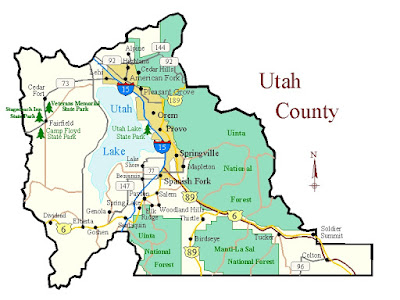I've decided to run for Utah County Commissioner Seat A next year, so I've been doing research on aspects of the county that I didn't know about especially the smaller towns. Current County Commissioner Nathan Ivie ran his campaign last year with one interesting issue, "create balanced commission districts so every community has a voice".
Utah County has a population just over 600,000 and with the continued growth happening, the Kem C. Gardner Policy Institute at the University of Utah performed long-term demographic projections for the state of Utah that was released this month. The Gardner Policy Institute projected that Utah County should be over the 1 million mark by the year 2037. To prepare for the future the county should change the structure of the county government.
I researched the composition of county governments and only included counties that had a population in the one million range from the 2010 census. I did not include New York County, New York and Philadelphia County, Pennsylvania because the city and county share government responsibilities. The following counties were included: King County, Washington; Clark County, Nevada; Travis/Tarrant/Bexar County, Texas; Contra Costa/Sacramento/Alameda/Santa Clara County, California; Orange/Hillsborough/Palm Beach/Broward County, Florida; Oakland/Wayne County, Michigan; Middlesex County, Massachusetts; Nassau/Bronx/Suffolk County, New York; Franklin/Cuyahoga County, Ohio; Allegheny County, Pennsylvania; Hennepin County, Minnesota; Fairfax County, Virginia; and Salt Lake County, Utah.
Currently Utah County has three county commissioners that are elected alternating two years for four year terms in a partisan election. Most of the other county governments have partisan elections, but a couple have nonpartisan elections. The million range county governments structure is varied, with only one other county having three commissioners. No matter the county government structure only one had a six year term, Salt Lake County, the rest had four year terms. Salt Lake County has a mayor with three countywide, six year terms, and six by district, four year terms, county council. One other county elects a mayor countywide with six commissioners by district. Eight counties have a county executive with a county council. The council consists of between 9 to 21 elected either whole or partially countywide or by district. Two counties elect commissioners (seven and nine), then the commissioners elect a mayor and vice-mayor among themselves. In Texas, they call it the Commissioners' Court composed of a county judge and four county commissioners. The county judge will be elected countywide and the four commissioners can either be elected countywide or by districts. In California, it's called the County Board of Supervisors which can consist of five Supervisors by district or countywide, one chair voted countywide with nine Supervisors voted by district, or one County Executive Officer with five Supervisors. Three counties have seven commissioners elected either whole or partially countywide or by district. One county elects five Port Commissioners countywide. A couple of counties hire a county manager to handle the day to day activities.
A couple of the counties mentioned that the unincorporated areas, which the county government has jurisdiction over, have community councils for planning purposes. I would think the community councils could also serve to have a better connection and communication with the Commissioners/county government.
I don't know what kind of future composition the county government will look like, but in my opinion since the county is responsible for serving the unincorporated areas, those areas should be represented more than the cities.
I am going to do a series of posts about Utah County issues to prepare for the election next year.

No comments:
Post a Comment